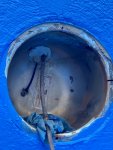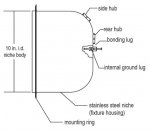There’s my confusion. Ours IS sealed with epoxy or putty of some sort. Why would one NOT seal the back of the niche where the wiring pulls through? Seems an added safety measure to me. No?This video shows one of the best ways it works under water - very short simple video. The light housing with glass lens he removes is sealed and the electrical connection coming into the housing is sealed. Near the end of the video he goes back underwater and shows where the conduit connects to the niche. You can see that is not sealed. The electrical wiring from the light travels through that conduit all the way back to the above ground junction box. You can see it is not sealed and would also have water in it.
This is why any splice you made would have water on it and not be safe or protected. The only splice should be at the end of that conduit above ground in a sealed box.
If the niche in your pool is good, you need a new sealed light housing with a cord/wire long enough to be fished all the way back to where that conduit comes out of the ground.
Pool is currently empty as we just finished painting it yesterday and waiting for paint to cure before refill. But now that I’m thinking about it, we noticed a line going down the wall from the niche a couple days after we drained it. Looked like where water had gone down. Didn’t think much of it. But now I know where it was coming from - leaking through the putty. So this answers the question of whether or not there’s conduit ran all the way. Wouldn’t have leaked 2 days later if there wasn’t.



